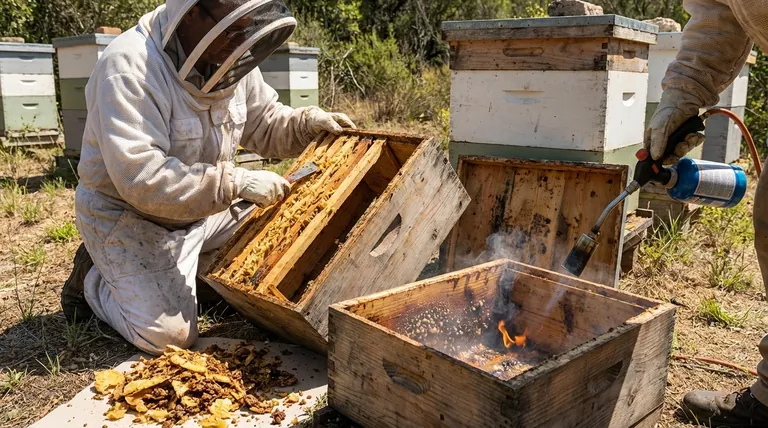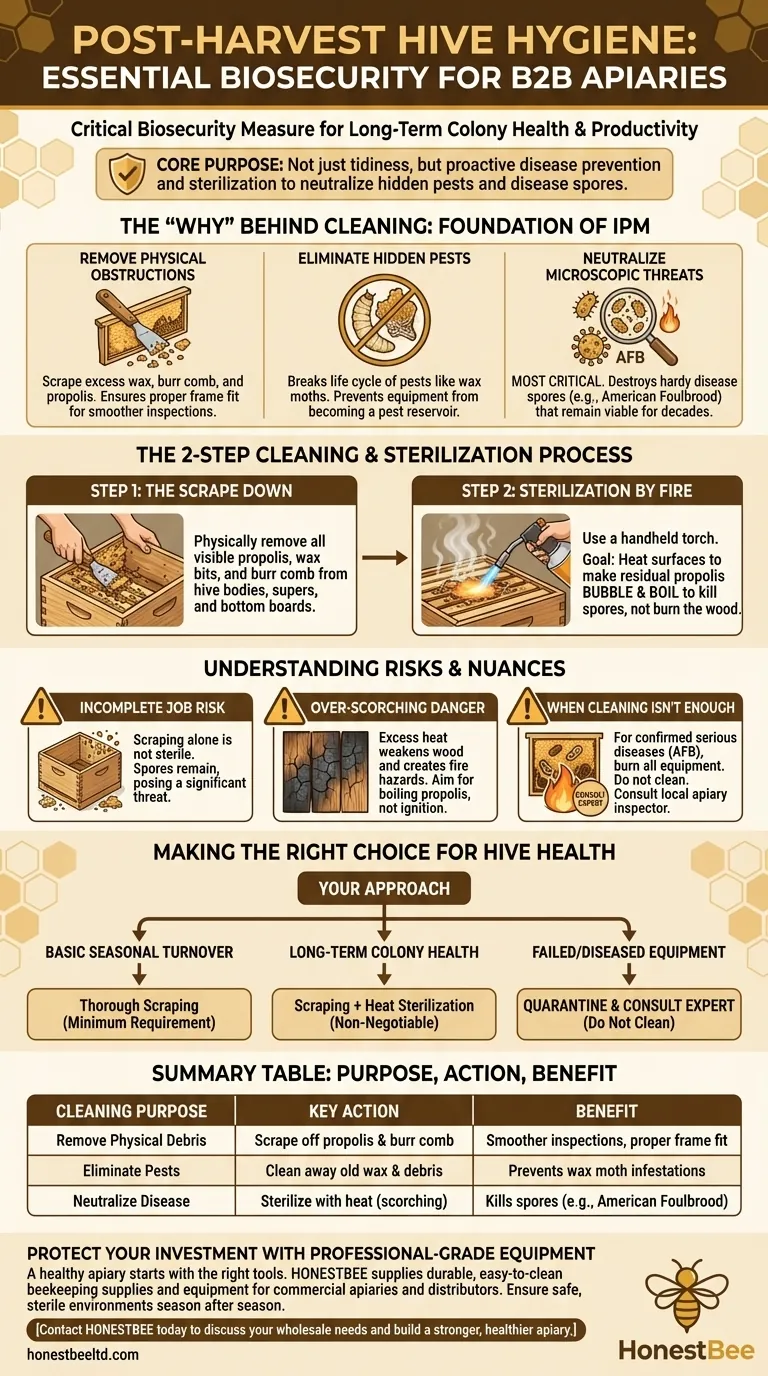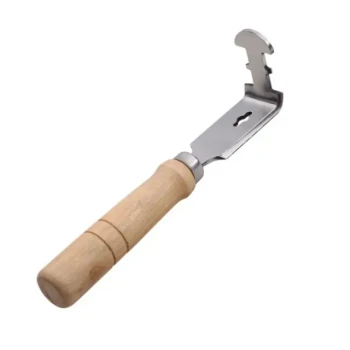At its core, cleaning hive boxes and frames after the honey harvest is a critical biosecurity measure. This process removes excess wax, burr comb, and propolis, but its most important function is to sterilize the equipment. By doing so, you eliminate hidden pests and neutralize disease spores, ensuring the hive is a safe, healthy environment for your bees in the next season.
The goal is not simply tidiness; it's proactive disease prevention. A thorough cleaning after the harvest is one of the most effective actions a beekeeper can take to protect their colony's long-term health and productivity.

The "Why" Behind Post-Harvest Cleaning
Cleaning your equipment is a foundational part of Integrated Pest Management (IPM) for your apiary. It breaks the life cycle of pests and pathogens that can hide in old comb and propolis.
Removing Physical Obstructions
Your bees build burr comb and apply propolis (a resinous "bee glue") throughout the hive. While propolis has antiseptic properties, excessive buildup can be a problem.
Thoroughly scraping the inside of boxes and the edges of frames removes this debris. This ensures frames fit properly, making future hive inspections smoother and less disruptive for the colony.
Eliminating Hidden Pests
Empty, uncleaned hive equipment is an ideal breeding ground for pests, especially wax moths.
Wax moth larvae tunnel through and consume old beeswax, destroying drawn comb and leaving behind a mess of webbing and feces. Storing dirty frames and boxes creates a pest reservoir that can infest your apiary next season.
Neutralizing Microscopic Threats
This is the most critical reason for cleaning. Beehives can harbor microscopic spores of devastating diseases, such as American Foulbrood (AFB), which can remain viable for decades in old equipment.
Simple scraping is not enough to eliminate these threats. Sterilization, typically through scorching, is necessary to destroy these hardy spores and prevent a catastrophic outbreak in a future colony.
The Two-Step Cleaning and Sterilization Process
A complete cleaning involves two distinct stages: physical removal of debris and heat sterilization.
Step 1: The Scrape Down
First, use a standard hive tool to vigorously scrape all interior surfaces of the hive bodies, supers, and bottom boards.
Focus on removing all visible propolis, bits of wax, and any remaining burr comb. This step clears away the material that can harbor pests and pathogens.
Step 2: Sterilization by Fire
After scraping, use a handheld propane torch to sterilize the wooden components. This is not about burning the wood.
The goal is to move the flame systematically across the interior surfaces, heating them just enough to make the residual propolis bubble and boil. This temperature is sufficient to kill disease spores without causing significant charring or damage to the wood.
Understanding the Risks and Nuances
While essential, the cleaning process must be done correctly to be effective and safe.
The Risk of an Incomplete Job
Simply scraping a box without scorching it is only doing half the job. You may have a physically clean box, but it is not sterile. Disease spores can remain, posing a significant threat to the next colony that occupies it.
The Danger of Over-Scorching
Applying too much heat for too long will char and weaken the wood. This can reduce the lifespan of your equipment and, in extreme cases, create a fire hazard. The key is to keep the flame moving and aim for boiling the propolis, not igniting the wood.
When Cleaning Isn't Enough
If a colony has died from a confirmed case of a highly contagious disease like American Foulbrood, cleaning is not a safe option.
In such cases, the standard and legally required protocol in many areas is to burn all frames and hive bodies to prevent the disease from spreading to other colonies in your area. Always consult your local apiary inspector if you suspect a serious disease.
Making the Right Choice for Hive Health
Your approach should be guided by your commitment to proactive disease management.
- If your primary focus is basic seasonal turnover: A thorough scraping of all propolis and burr comb is the minimum requirement for preparing equipment for storage or immediate reuse.
- If your primary focus is long-term colony health: Adding heat sterilization by scorching the boxes is a non-negotiable step to neutralize invisible disease threats.
- If you are dealing with equipment from a failed or diseased colony: Do not clean it. Quarantine the equipment immediately and consult a local beekeeping expert or apiary inspector for guidance on diagnosis and safe disposal.
Ultimately, a clean and sterile hive is the foundation upon which a strong, productive colony is built.
Summary Table:
| Cleaning Purpose | Key Action | Benefit |
|---|---|---|
| Remove Physical Debris | Scrape off propolis and burr comb | Smoother inspections, proper frame fit |
| Eliminate Pests | Clean away old wax and debris | Prevents wax moth infestations |
| Neutralize Disease | Sterilize with heat (scorching) | Kills spores of diseases like American Foulbrood |
Protect Your Investment with Professional-Grade Equipment A healthy apiary starts with the right tools. HONESTBEE supplies durable, easy-to-clean beekeeping supplies and equipment to commercial apiaries and distributors through our wholesale-focused operations. Ensure your colonies have a safe, sterile environment season after season.
Contact HONESTBEE today to discuss your wholesale needs and build a stronger, healthier apiary.
Visual Guide

Related Products
- Professional Galvanized Hive Strap with Secure Locking Buckle for Beekeeping
- Versatile Ratchet Hive Strap with S-Hooks for Secure Fastening
- Wooden Queen Bee Excluder for Beekeeping
- Professional Stainless Steel Frame Cleaner with Ergonomic Wood Handle
- Professional Wide Blade Honey Scraper for Beekeeping and Honey Processing
People Also Ask
- How can beekeepers secure the top cover of a hive? Protect Your Colony from Wind and Weather
- What maintenance is required for hive straps? A Guide to Cam Buckle vs. Ratchet Strap Care
- What is the advantage of using cam buckle straps? Secure Your Load Fast with Simple, Safe Tensioning
- Why are hive straps important for beekeepers? Secure Your Hives Against Wind, Predators & Transport
- What are hive straps and why are they used? Secure Your Hives Against Wind, Predators, and Transport



















